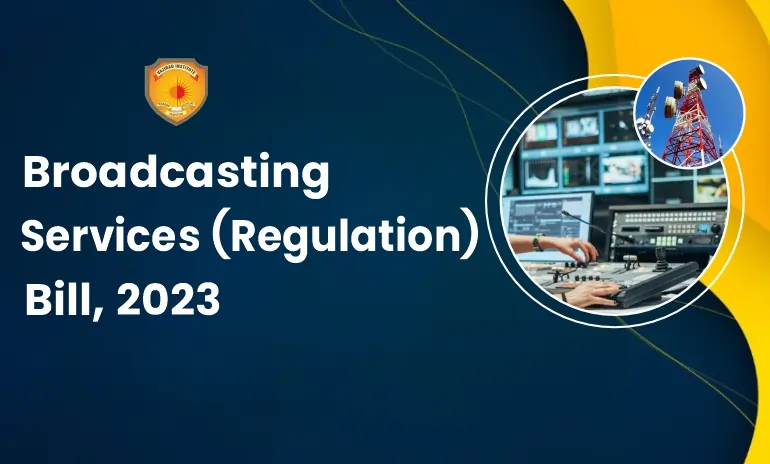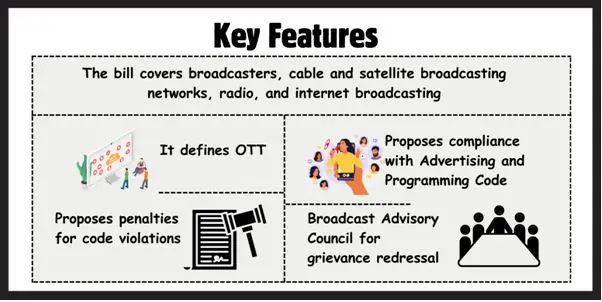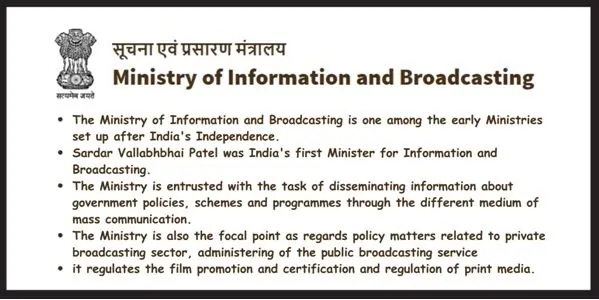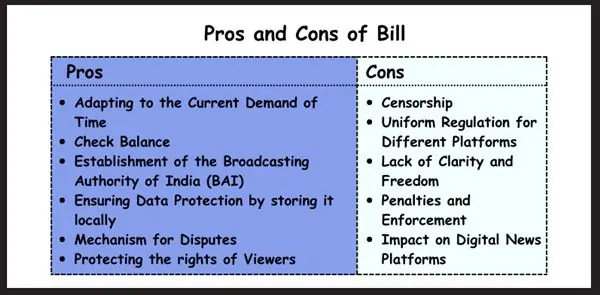
The advancement in technology specifically in the broadcasting industry with most of the cable TV going digital requires simplification of the large number of regulatory frameworks in place. This facilitates the businesses to reduced government pressure and work on smooth function of the platforms under the regulations. Thus, understanding the need for the integrated approach, it is necessary to change the existing fragmented legal regulation and adopt a new statute.Government of India in its Ministry of Information and Broadcasting had tabled a Broadcasting Services (Regulation) Bill 2023 as a draft. This bill has a aim to eradicate the out-dated laws and bring a common law for regulating all the digital services for broadcasting.
The Bill simplifies the procedures, expands its coverage to Over-the-Top material and digital newspapers, and includes modern definitions of requirements for further growing technologies. The Proposal recommends implementing self-regulation through the establishment of Broadcast Advisory Council and Content Evolution committee. Also it has provision for the penalties for the offenders.
This bill consists of three Schedules and 48 sections comprised in its six chapters.

Key highlights of the Bill:
- Accessibility for People with Disabilities: Even though it has a goal of dealing with the needs of those with disabilities, as a way of achieving this act, it prescribes procedures for the development of extensive accessibility standards.
- Consolidation and Modernization: It meets an important long standing need to harmonize and bring up to date regulatory regulations of multiple broadcasting services under one Act. It advances the regulation procedure since it is efficient, faster and more progressive as compared to the first step. It expands its regulatory jurisdiction to encompass sending through the Internet content other than voice communications, which as OTT content, digital news, and current affairs are regulated by the IT Act of 2000 and the rules framed thereafter.
- Current Definitions and Future-Ready Provisions: As a result of the advancement in technologies and services the law contains evolutionary meanings of the currently prevailing broadcasting terms and also provisions for the future broadcasting technologies.
- Distinct Programme Code and Advertisement Code: It allows the different approach to Programme and Advertisement Codes across the services, the broadcasters’ classification of programmes and effective means of access control regarding the restricted programmes.
- Equitable Penalties: penalties with fines are linked to the financial capacities of the entity and investment/turnover, which provides justice and equity.
- Infra-Sharing and Services:in this law there are various provisions for transmitting and broadcasting to various networks. Moreover, it simplifies the Right of Way section to respond and facilitate the relocation and adjustments much more quickly, and it introduces a methodical approach to the settlement of disputes.
- Statutory Penalties and Fines: The proposed Bill prescribes penalties that are statutory in nature some of which include advice, warning, censure and fines. The provision for jail and/or fines is still there, but limited for only the worst offenders; thus ensuring that the scales of the regulator will always be balanced.
- Strengthens the Self-Regulation Regime: They enhance self-regulation in order to create ‘Content Evaluation Committees’ and to develop the current blunt Inter-Departmental Committee into the wider ‘Broadcast Advisory Council’.

Pros of Bill:
The Broadcasting Services (Regulation) Bill, 2023, in India is a proposed bill that seeks to reform the broadcasting services’ regulation. If we talk about the pros associated with this bill we can see by the below points:
Adapting to the Current Demand of Time:
- The contents of the bill aim at repealing the Cable Television Networks (Regulation) Act of 1995, which is comparatively archaic. Thus, it recognizes the dynamism in the development of technology, and the existence of new platforms other than the cable television.
- It expanses its jurisdiction to OTT content and Digital News to capture the importance of these platforms in today’s world of media.
- This inclusivity makes it possible that regulations are the same to the different channels of broadcasting encouraging fairness.
Check Balance:
- The goal of the bill is to defend the First Amendment rights but also to act as a police force of speakers who promote terrible content.
- Simultaneously it serves as a link between media and broadcasting responsibility and freedom of creative expression and ideas.
Establishment of the Broadcasting Authority of India (BAI):
- The bill postulates establishment of the Broadcasting Authority of India (BAI) which is a new authority. The BAI would be responsibility for the putting into effect of the bill and observing compliance with the law.
- Thus, wherein the organization has a specific authority for policy execution, it can help in better capability to decide and organize, promote transparency and eventually viewers may also get better options for grievance redressal.
Ensuring Data Protection by storing it locally:
- The bill requires some intermediaries to exclusively store or transmit data local to India.
- This facilitates data protection and ownership as the information is not stored across borders managers can keep of records.
Mechanism for Disputes:
- Some of its clauses reflect recommendations for infrastructure cooperation between carriers of platform services and broadcasting network providers.
- It improves the Right of Way section, expansion and any changes that may be needed can be arranged.
Protecting the rights of Viewers:
- It deals with matters like hate speech, fake news and violence in contents through codes and age verification aspects.
- It’s supposed to adapt recommendations from that policy and help make Indian programming more widely available on every media.
- This way, viewers’ interests are protected given that program quality and intent are maintained.

Cons of bill:
While the bill intends to modernize the broadcasting industry, it has prompted various concerns:
- The bill extends the government extensive power over the content shown by OTT platforms and digital news publishers, resulting in censorship and self-censorship.
- Comparing cable TV and online platforms and placing them into the same regulatory net erases these differences and may well end up infringing on the freedom of speech.
- The bill addresses self-regulation through the content evaluation committees as ambiguous and not very independent. The regulation says that only the certified programs must be transmitted through the over-the-top platforms.
- The details of certification and the membership of the committee are still unknown.
- Some risks exists relate to the government interference with digital media when platforms have to adhere to the official certification programs.
- The bill also provides the measures to be taken against non-compliance and these includes advisory action, warning, censure, fines and in case of gross infringement a term of imprisonment.
- Critics fear that when sanctions are tight, new ideas will not be produced hence the smaller firms will be discouraged.
- Regarding freedom and independence of the journalism, the extension of the act to the digital news platform is questionable.
IT Act, 2000
Legal recognition:
- Information Technology act of the year 2000 acknowledges the electronic contracts as legal and valid if such contracts are made electronically and through secure methods. It affords legal identity to digital signatures making them to be as effective as mechanical signatures.
- This recognition assists in electronic transactions due to the confirmation that the transactions are genuine and can be supported in court.
Security Measures for Electronic Records:
- It becomes clear that e-governance has a legal standing by creating the understanding of electronic documents,that it will ensure the content is safe, shielded, and that no changes have been made to its contents.
- The IT Act recognizes the electronic record and thereby encourages confidence in applying electronic media for transactions or communications.
CYBER Crime:
- This piece of legislation transforms miscellaneous cybercrimes into criminal acts that include but are not limited to entering computer systems with a criminal intention, hacking, stealing data as well as sharing viruses.
- It prescribes punishment for various crimes that are from fines to jail. Such fines help discourage cybercrime as per the law of averages.
CCA:
- According to the Act, Controller of Certifying Authorities (CCA) was established and it directs complicated digital signature matters. The CCA also confirms to the users that the digital certificates are authentic and accurate.
- Digital signatures are critical elements for opening the confidentiality and safety of lots of conversation and interactions.
CAT:
- The best legal arrangement under the IT Act is the option of Cyber Appellate Tribunal (CAT) that deals with problems of this law.
- The law exempts the CAT but make the institution an appellate body on cybercrime issues to help in restitution and proper judiciary determination.